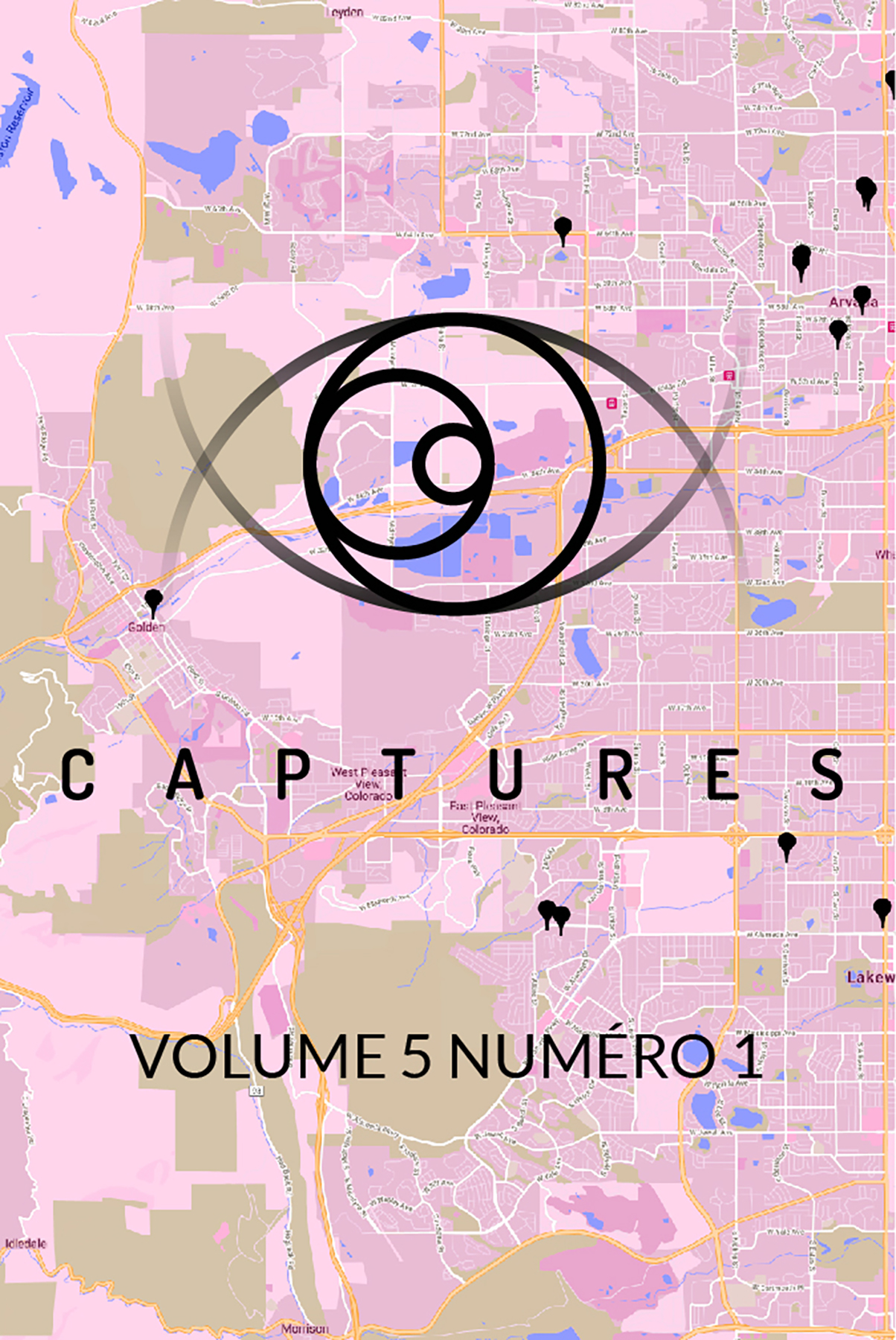Abstracts
Résumé
L’espace numérique — à la fois multiple et intriqué à l’espace tangible — requiert une approche cartographique spécifique. En mobilisant les notions de savoirs situés et de diagrammatique sensible, cette étude de l’Atlas critique d’Internet (2012) de Louise Drulhe montre, d’une part, comment l’espace affecte les internets et leurs représentations, et, d’autre part, comment l’atlas s’avère la forme la plus adéquate pour concevoir les spatialités complexes du numérique.
Abstract
The digital space — as multiple and hybridized with offline space — requires a specific cartographic approach. Mobilizing the notions of situated knowledges and sensitive diagrammatics, this study of Louise Drulhe’s Critical Atlas of Internet (2012) demonstrates on the one hand how space affects the internets and their representations, and on the other hand, how the atlas turns out to be the most appropriate form to conceptualize the complexities of digital space.
Appendices
Bibliographie
- [s. a.]. 2018. « Cyberespace ». Office québécois de la langue française. http://gdt.oqlf.gouv.qc.ca/ficheOqlf.aspx?Id_Fiche=8355974. Consultée le 14 mai 2020.
- [s. a.]. 2019. « Apprentissage profond ». Office québécois de la langue française. http://gdt.oqlf.gouv.qc.ca/ficheOqlf.aspx?Id_Fiche=26532876. Consultée le 14 mai 2020.
- Beaude, Boris. 2012. Internet. Changer l'espace, changer la société. Limoges : FYP, 256 p.
- Castro, Teresa. 2013. « Atlas. Pour une histoire des images “au travail” ». Perspective, vol. 1, p. 161-167.
- Chatonsky, Grégory. 2007. « L'esthétique du flux ». Rue Descartes, vol. 55, no 1, p. 86-99.
- De Souza e Silva, Adriana et Mimi Sheller. 2015. Mobility and Locative Media. New York : Routledge, 288 p.
- Deleuze, Gilles et Félix Guattari. 1980. Mille plateaux. Capitalisme et schizophrénie 2. Paris : Minuit, « Critique », 644 p.
- Deleuze, Gilles. 1986. Foucault. Paris : Minuit, 144 p.
- Di Méo, Guy. 1991. L'homme, la société, l'espace. Paris : Anthropos, 319 p.
- Didi-Huberman, Georges. 2011. Atlas ou Le gai savoir inquiet. L'Oeil de l'histoire 3. Paris : Minuit, « Paradoxe », 384 p.
- Dodge, Martin et Rob Kitchin. 2001. Atlas of Cyberspace. Londres : Pearson Education, 288 p.
- Douzet, Frédérick (dir.). 2014. Dossier « Cyberespace. Enjeux géopolitiques ». Hérodote, vol. 1-2, no 152-153. https://www.cairn.info/revue-herodote-2014-1.htm. Consultée le 14 mai 2020.
- Drulhe, Louise. 2012. Atlas critique d'Internet. http://internet-atlas.net/. Consultée le 7 août 2019.
- Farman, Jason. 2012. Mobile Interface Theory. Embodied Space and Locative Media. New York : Routledge, 172 p.
- Gibson, William. 1982. « Burning Chrome ». Omni, vol. 4, no 10, juillet, p. 72.
- Gibson, William. 1984. Neuromancer. New York : Ace, 271 p.
- Gordon, Eric et Adriana De Souza e Silva. 2011. Net Locality. Why Location Matters in a Networked World. Hoboken : Blackwell, 200 p.
- Haraway, Donna. 1988. « Situated Knowledges. The Science Question in Feminism and the Privilege of Partial Perspective ». Feminist Studies, vol. 14, no 3, automne, p. 575-599.
- Jameson, Fredric. 1988. « Cognitive Mapping », dans Cary Nelson et Lawrence Grossber (dir.), Marxism and the Interpretation of Culture. Urbana : University of Illinois Press, p. 347-360.
- Jameson, Fredric. 1991. Postmodernism, or the Cultural Logic of Late Capitalism. Durham : Duke University Press, 438 p.
- Joliveau, Thierry, Matthieu Noucher et Stéphane Roche. 2013. « La cartograhie 2.0, vers une approche critique d’un nouveau régime cartographique ». L'information géographique, vol. 77, no 4, p. 29-46.
- Latour, Bruno. 2007. « Paris, ville invisible. Le plasma », dans Airs de Paris, 30 Ans Du Centre Pompidou. Paris : ADGP, p. 1-7. http://www.bruno-latour.fr/sites/default/files/P-123-BEAUBOURG-PARIS.pdf. Consultée le 14 mai 2020.
- Lévy, Pierre. 1998. Qu'est-ce que le virtuel?. Paris : La Découverte, 160 p.
- Lussault, Michel. 2007. L’homme spatial. La construction sociale de l’espace humain. Paris : Seuil, 400 p.
- Lynch, Kevin. 1960. The Image of the City. Cambridge : MIT Press, 194 p.
- Martel, Frédéric. 2014. Smart. Enquête sur les internets. Paris : Stock, 408 p.
- Morozov, Evgeny. 2013. To Save Everything, Click Here. The Folly of Technological Solutionism. Jackson : Public Affairs, 415 p.
- Nova, Nicolas. 2009. Les médias géolocalisés. Comprendre les nouveaux paysages numériques. Limoges : FYP, 256 p.
- Orwell, George. 1949. 1984. Londres : Secker and Warburg, 376 p.
- Pariser, Eli. 2011. The Filter Bubble. What the Internet is Hiding From You. New York : Penguin Random House, 304 p.
- Rancière, Jacques et Christine Palmiéri. 2002. « Compte-rendu de Jacques Rancière “Le partage du sensible” ». ETC, vol. 59, p. 34-40.
- Scott, Ridley (réal.). 1984. 1984, vidéoclip publicitaire. États-Unis : Fairbanks, 1 min. https://youtu.be/vNy-7jv0XSc.
- Sunstein, Cass. 2001. Republic.com. Princeton : Princeton University Press, 224 p.
- Veel, Kristin. 2003. « The Irreducibility of Space. Labyrinths, Cities, Cyberspace ». Diacritics, vol. 33, no 3-4, p. 151-172.
- Vitali-Rosati, Marcello. 2012. S'orienter dans le virtuel. Paris : Hermann, 178 p.
- Wachowski, Lana et Lilly Wachowski (réal.). 1999. The Matrix, 3 films. The Matrix (1999), The Matrix Reloaded (2003), The Matrix Revolutions (2003). États-Unis : Warner Bros.
- Wu, Tim. 2003. « Network Neutrality, Broadband Discrimination ». Journal on Telecom and High Tech Law, vol. 2, p. 141.
- Zittrain, Jonathan R. 2008. The Future of Internet – And How to Stop It. New Haven : Yale University Press, 352 p.


